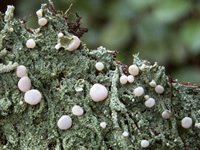For those interested in lichens, a good time to have a walk in the woods to see those that call the trees their home, is after a wind storm. There are many trees that prune themselves with the result being scattered branches, broken off by the wind or heavy snows. A quick stroll amongst the fallen twigs and branches reveal many of these tree dwelling lichens. |
| |
|
|
 |
__ |
 |
Hairy Parchment, Stereum hirsutum group (fungi) |
|
Stag Horn Lichen, Evernia prunastri (lichen) |
| |
|
|
Lichens are organisms consisting of a fungus and a green or blue-green alga growing together in a mutually beneficial, symbiotic, relationship. The entire structure is called a thallus. The fungus obtains water and minerals from the air and the material it is growing on. The alga provides carbohydrates and vitamins. |
| |
|
|
 |
|
 |
Rag Bag, Platismatia glauca (lichen)
(underside colours visible) |
|
Rag Bag, Platismatia glauca (lichen) |
| |
|
|
Lichens may be flat, leafy, or branched and hair like. All three forms occur on tree bark as well as rocks, soil, and other substrates. Colours may range from white to gray, red, green, yellow, and black. Those that grow on tree bark are not parasitic and do not harm the tree. Lichens grow rapidly when exposed to full sunlight and clean air. Most will not grow in a smoky or polluted atmosphere. You will also find fungi and some of these have great colours and very interesting shapes if you can view them though a macro lens or magnifying glass. |
| |
|
|
 |
|
 |
Pincushion Orange Lichen, Xanthoria polycarpa
This lichen is very small; almost like dust. The twig it is on is about the diameter of a pencil! |
| |
|
|
We hope this introduction whets your appetite to learn more and get out your camera set to ultra close-up while you discover lichens. The colours and formations you'll come upon are truly amazing.
|









